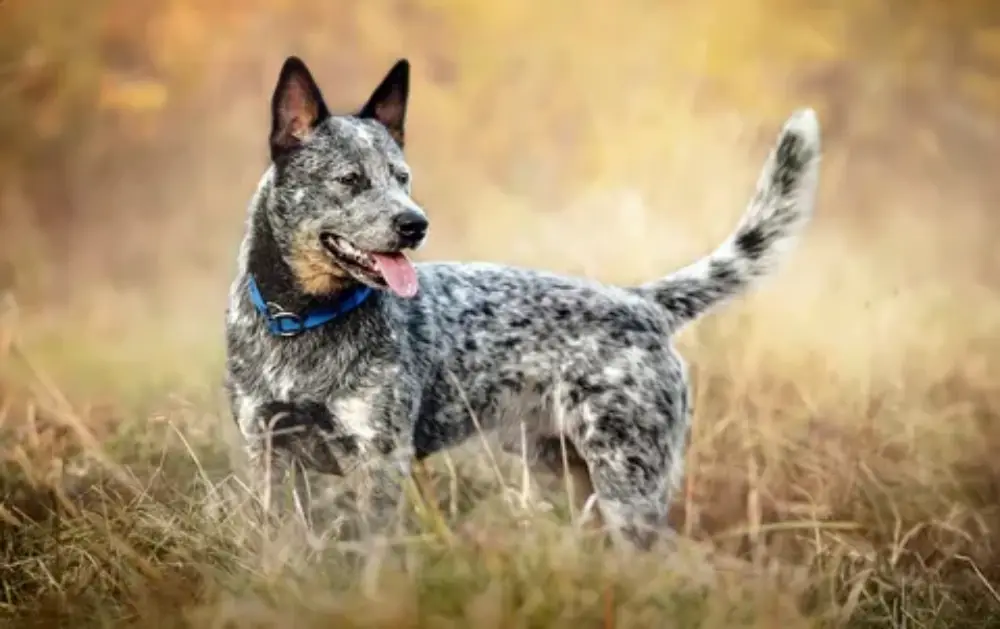Australian Cattle Dog History
In the early 1800s, vast land areas in Australia became available for grazing cattle. The cattle raised on these lands became so wild and intractable that the traditional European herding breeds that had proved satisfactory on tamer cattle were no longer suited for the job. An Australian Cattle Dog was needed that could withstand traveling long distances over rough terrain in hot weather and that could control cattle without barking (which only served to make wild cattle wilder).
In 1840, a man named Hall bred some smooth blue merle Highland Collies to Dingos, producing a strain known as Hall’s Heelers. One particularly influential stud was a dog named Bentley’s Dog, who is credited with stamping the white blaze found on the head of Australian Cattle Dogs today.

Other breeders crossed their Hall’s Heelers with other breeds, including the Bull Terrier, Dalmatian, and, later, Black and Tan Kelpie, a sheepherding breed. The result was a dog with the herding instincts of the Collie and Kelpie, the endurance, ruggedness, and quiet style of the Dingo, and the horse sense and protectiveness of the Dalmatian, all with a distinctively patterned coat.
As the dogs became increasingly vital to the cattle industry of Queensland, they gained the name Queensland Blue Heeler. They later became known as Australian Heeler, and then Australian Cattle Dog. A standard for the breed, emphasizing its Dingo characteristics, was drawn up in 1897. The Australian Cattle Dog was slow to catch on in America, however, perhaps because it bore little resemblance to established herding breeds.
When given a chance, it proved its merits and was welcomed as a herder and pet. The AKC recognized the breed in 1980, and it has since become a capable show dog, without sacrificing its functional makeup.
Temperament
Smart, hardy, independent, stubborn, tenacious, energetic, and untiring-these are all traits essential to a driver of headstrong cattle, and all traits of the Australian Cattle Dog. This dog must have a job to do or it will expend its efforts on unacceptable jobs of its own. Given challenging mental and hard physical exercise daily, it is among the most responsive and obedient of dogs an exemplary partner in adventure. It tends to nip at the heels of running children.
Upkeep
The Australian Cattle Dog was bred to be active and tireless. This dog needs a lot of physical and mental activity, more than a simple walk on a leash can provide. A good jog or long workout, coupled with obedience lessons or other intellectual challenges, is essential every day. It is happiest when it has a job to perform especially when that job is herding. The Australian Cattle Dog can live outdoors in temperate to cool climates. It is unsuited for apartment life. Its coat needs brushing or combing weekly to remove dead hairs.
Australian Cattle Dog Health
- Major concerns: CHD, OCD, deafness, PRA
- Minor concerns: none
- Occasionally seen: cataract, lens luxation, PPM
- Suggested tests: hip, hearing, eye
- Life span: 10-13 years
Form and Function
The Australian Cattle Dog is of moderate build, enabling it to combine great endurance with bursts of speed and extreme agility necessary in controlling unruly cattle. It is sturdy and compact. slightly longer than it is tall. Its gait is supple and tireless, and it must be capable of quick and sudden movement. Its ability to stop quickly is aided by the rudderlike action of its tail (which is never docked). Its weather-resistant coat consists of a short, dense undercoat and a moderately short, straight outer coat of medium texture.









